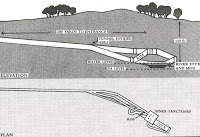Over at Smithsonian magazine, there’s a terrific article about the Cave of the Sybil at Baia, near Naples. It speculates that the site was used to mimic (or, less charitably, trick people into thinking they were actually) traveling to the underworld. There are apparently multiple tunnels, an underwater stream (heated “to near boiling” by the subterranean volcanic activity; the place is only a few miles from Mt. Vesuvius), hidden staircases, concealed doors; all it needs are pig-faced orcs.
Within the portion of the tunnels choked by rubble, Paget and Jones found, hidden behind an S-bend, a second blockage. This, the explorers discovered, marked the place where two tunnels diverged. Basing his thinking on the remains of some ancient pivots, Paget suggested that the spot had at one time harbored a concealed door. Swung closed, this would have masked the entrance to a second tunnel that acted as a short-cut to the lower levels. Opened partially, it could have been used (the explorer suggested) as a remarkably effective ventilation system; hot, vitiated air would be sucked out of the tunnel complex at ceiling level, while currents of cooler air from the surface were constantly drawn in along the floor.
The article also has several awesome maps, such as that above, that readers here might find interesting.










Thanks for the pointer, Joe!
Allan.
Nice!